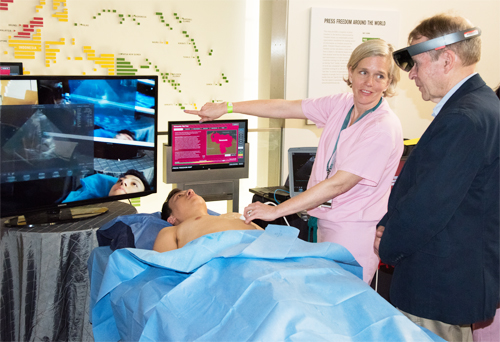Could the technology that powers games like Pokémon GO be used for surgery in the near future? Researchers at the University of Maryland think so.
Amitabh Varshney, a computer science professor and director of the Augmentarium facility at the University of Maryland, along with four other physicians and researchers, showed off the use of augmented reality in medical procedures on March 27 with a demonstration of how it could be used in intubation with the help of ultrasounds.
The demonstration, run by Dr. Sarah Murthi, associate professor at the University of Maryland School of Medicine and trauma surgeon at the Shock Trauma Center, showed that with AR, medical staff can view important data in their field of vision without looking away from the patient. The ultrasound images are overlayed on the patient via the AR headset, which helps aid in insertion of a tube without every glancing away. This could improve procedures that typically involve split attention between the patient and a display containing essential information.

Dr. Sarah Murthi explains the augmented reality technology used to perform an ultrasound scan on a volunteer patient during the March 27 event.
In the case of intubation, a medical professional would only need to look down at their patient, and would "see through" their patient in order to accurately perform the procedure. Currently, the procedure has to be juggled between the patient and a video feed from inside them, but with AR, these actions could be combined into one.
The Augmentarium is a department that specializes in augmented and virtual reality technology, developing tools and spaces for learning and practical application in a virtual environment. Together with the University of Maryland Medical Center's Shock Trauma Center, they developed the software necessary to perform AR medical procedures, which run on Oculus and HoloLens headsets.
One company whose work mirrors the University of Maryland is CAE Healthcare. They've developed VimedixAR, software that works with the HoloLens to be used for medical purposes. Like Varshney's work, CAE Healthcare's software allows both for educational and practical application. Students can use it to practice without any risk to a real patient, and when they are ready to, they can enter the operating room with these indispensable AR tools.
Doctors have already proven AR to be highly useful during surgery; two used the technology to simplify spinal surgery, and have even had the chance to use it in a real setting by implementing it into collarbone surgery, improving the accuracy of the procedure. It seems to be only a matter of time before AR becomes more mainstream in the medical field. We'll be watching as it does.
- Follow NextReality on Facebook, Twitter, and YouTube
- Follow WonderHowTo on Facebook, Twitter, Pinterest, and Google+
Cover image via University of Maryland, Baltimore/Facebook

























Comments
Be the first, drop a comment!